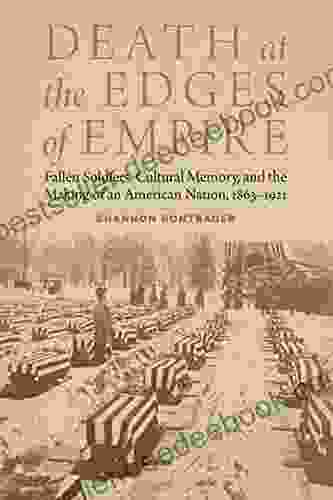Fallen Soldiers, Cultural Memory, and the Making of an American Nation: 1863-1921

The American Civil War was one of the deadliest conflicts in U.S. history, with over 620,000 soldiers killed. The war left a deep scar on the nation's psyche, and the memory of the fallen soldiers played a major role in shaping American culture and identity in the years that followed.
In the immediate aftermath of the war, the memory of the fallen was used to promote reconciliation and healing. In 1865, President Abraham Lincoln delivered his famous "Gettysburg Address," in which he called for the nation to "be dedicated here to the unfinished work which they who fought here have thus far so nobly carried on." Lincoln's words helped to inspire the creation of national cemeteries, such as Arlington National Cemetery, where fallen soldiers could be buried with honor.
4.2 out of 5
| Language | : | English |
| File size | : | 5457 KB |
| Text-to-Speech | : | Enabled |
| Screen Reader | : | Supported |
| Enhanced typesetting | : | Enabled |
| Word Wise | : | Enabled |
| Print length | : | 400 pages |
| Lending | : | Enabled |
The memory of the fallen was also used to promote a sense of national unity. In the years following the war, the Grand Army of the Republic (GAR),a veterans' organization, played a major role in promoting the memory of the fallen. The GAR organized parades, memorials, and other events to commemorate the sacrifices of the soldiers who had fought and died in the war. These events helped to create a shared sense of identity among veterans and their families, and they also helped to promote a sense of national pride.
The memory of the fallen was also used to justify the expansion of American power. In the late 19th century, the United States emerged as a global power, and the memory of the fallen was used to justify the country's involvement in wars such as the Spanish-American War and World War I. These wars were seen as a way to avenge the deaths of the fallen soldiers and to protect the nation's honor.
The memory of the fallen soldiers also played a role in the development of American popular culture. In the late 19th and early 20th centuries, the memory of the fallen was used to create a variety of popular songs, poems, and stories. These works of art helped to keep the memory of the fallen alive and they also helped to shape the way that Americans thought about war and sacrifice.
The memory of the fallen soldiers also had a profound impact on American government policies. In the years following the Civil War, the government created a number of programs to provide benefits to veterans and their families. These programs included pensions, disability payments, and educational benefits. These programs helped to ensure that the sacrifices of the fallen soldiers were not forgotten and they also helped to provide a measure of security for veterans and their families.
The memory of the fallen soldiers has continued to play a major role in American culture and identity. In the 21st century, the memory of the fallen is still used to justify wars, to promote reconciliation, and to shape the way that Americans think about sacrifice and heroism.
Here are some specific examples of how the memory of the fallen soldiers was used to shape American culture and identity:
* In 1865, Congress created the National Cemetery System, which established national cemeteries in every state and territory. These cemeteries were designed to provide a place for fallen soldiers to be buried with honor and to serve as a reminder of the sacrifices that they had made. * In 1868, the Grand Army of the Republic (GAR) was founded. The GAR was a veterans' organization that played a major role in promoting the memory of the fallen. The GAR organized parades, memorials, and other events to commemorate the sacrifices of the soldiers who had fought and died in the war. * In 1898, the United States entered the Spanish-American War. The war was seen as a way to avenge the deaths of the fallen soldiers in the Civil War and to protect the nation's honor. * In 1917, the United States entered World War I. The war was seen as a way to protect the nation from the threat of German aggression and to make the world safe for democracy. * In 1921, the Tomb of the Unknown Soldier was dedicated at Arlington National Cemetery. The tomb is a memorial to the unknown soldiers who have died in service to their country. The tomb is a reminder of the sacrifices that have been made by American soldiers throughout history.
The memory of the fallen soldiers has played a major role in shaping American culture and identity. The memory of these soldiers has been used to promote reconciliation, healing, national unity, and the expansion of American power. The memory of the fallen has also been used to justify wars, to shape the way that Americans think about sacrifice and heroism, and to create a variety of popular songs, poems, and stories. The memory of the fallen soldiers is a powerful reminder of the sacrifices that have been made by American soldiers throughout history.
The memory of the fallen soldiers has played a complex and multifaceted role in American culture and identity. The memory of these soldiers has been used to promote reconciliation, healing, national unity, and the expansion of American power. The memory of the fallen has also been used to justify wars, to shape the way that Americans think about sacrifice and heroism, and to create a variety of popular songs, poems, and stories. The memory of the fallen soldiers is a powerful reminder of the sacrifices that have been made by American soldiers throughout history.
4.2 out of 5
| Language | : | English |
| File size | : | 5457 KB |
| Text-to-Speech | : | Enabled |
| Screen Reader | : | Supported |
| Enhanced typesetting | : | Enabled |
| Word Wise | : | Enabled |
| Print length | : | 400 pages |
| Lending | : | Enabled |
Do you want to contribute by writing guest posts on this blog?
Please contact us and send us a resume of previous articles that you have written.
 Chapter
Chapter Text
Text Story
Story Genre
Genre Paperback
Paperback E-book
E-book Newspaper
Newspaper Paragraph
Paragraph Sentence
Sentence Glossary
Glossary Bibliography
Bibliography Codex
Codex Bestseller
Bestseller Classics
Classics Narrative
Narrative Autobiography
Autobiography Memoir
Memoir Reference
Reference Encyclopedia
Encyclopedia Narrator
Narrator Character
Character Resolution
Resolution Librarian
Librarian Stacks
Stacks Archives
Archives Study
Study Research
Research Scholarly
Scholarly Lending
Lending Reserve
Reserve Reading Room
Reading Room Special Collections
Special Collections Interlibrary
Interlibrary Literacy
Literacy Study Group
Study Group Storytelling
Storytelling Awards
Awards Book Club
Book Club Theory
Theory Textbooks
Textbooks Simon Owedyk
Simon Owedyk Amitai Etzioni
Amitai Etzioni Sir Peter Hall
Sir Peter Hall Sara Knight
Sara Knight Allan B Cobb
Allan B Cobb David Horowitz
David Horowitz Terese Cato
Terese Cato Sarah Carleton
Sarah Carleton David Malet
David Malet Founding Fathers
Founding Fathers Winfried Lamersdorf
Winfried Lamersdorf Trevor Mackenzie
Trevor Mackenzie Donald N S Unger
Donald N S Unger Iris Krasnow
Iris Krasnow William Leavitt
William Leavitt Jason Troyer Phd
Jason Troyer Phd Brandon Royal
Brandon Royal Alison Taylor Brown
Alison Taylor Brown Meryl Urson
Meryl Urson Liz Ficalora
Liz Ficalora
Light bulbAdvertise smarter! Our strategic ad space ensures maximum exposure. Reserve your spot today!

 Jerry HayesKino Digital Hideout Diary of Roblox Murder Mystery Unofficial: An Extensive...
Jerry HayesKino Digital Hideout Diary of Roblox Murder Mystery Unofficial: An Extensive... Hank MitchellFollow ·18.2k
Hank MitchellFollow ·18.2k Galen PowellFollow ·14.7k
Galen PowellFollow ·14.7k Gene PowellFollow ·6.2k
Gene PowellFollow ·6.2k Emilio CoxFollow ·12.7k
Emilio CoxFollow ·12.7k Edgar CoxFollow ·8.2k
Edgar CoxFollow ·8.2k Osamu DazaiFollow ·7.9k
Osamu DazaiFollow ·7.9k Garrett PowellFollow ·5.2k
Garrett PowellFollow ·5.2k Simon MitchellFollow ·19.3k
Simon MitchellFollow ·19.3k

 Brian Bell
Brian BellClassic Festival Solos Bassoon Volume Piano...
The Classic Festival Solos Bassoon Volume...

 Aubrey Blair
Aubrey BlairUnveiling the Courage: Insurgent Women Female Combatants...
In the face of armed...

 Jan Mitchell
Jan MitchellFor The Liberty Of Texas: The Lone Star State's Fight for...
The Republic of Texas was a sovereign state...

 Edgar Allan Poe
Edgar Allan PoeVisible, Explainable, Trustworthy, and Transparent...
What is VET2...
4.2 out of 5
| Language | : | English |
| File size | : | 5457 KB |
| Text-to-Speech | : | Enabled |
| Screen Reader | : | Supported |
| Enhanced typesetting | : | Enabled |
| Word Wise | : | Enabled |
| Print length | : | 400 pages |
| Lending | : | Enabled |














